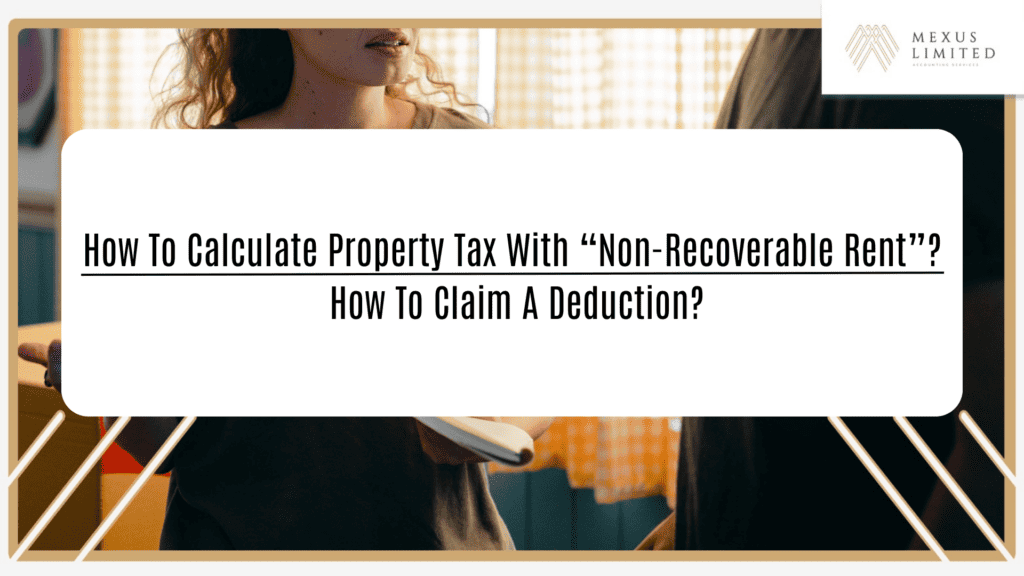How to calculate property tax with “non-recoverable rent”? How to claim a deduction?

Currently renting out properties in Hong Kong to collect rent, property tax must be declared. In calculating the net assessable value, there are three deductible items including rates, non-recoverable rent and repairs. If you are a landlord, you can claim “non-recoverable rent” as a tax deduction, but only for rent determined to be non-recoverable during the relevant year. How exactly do you define “non-recoverable rent”? How to declare and deduct the deduction, the following article will introduce you one by one:
How does the Inland Revenue Department define “non-recoverable rent”?
“Rent arrears” are not necessarily irrecoverable. How does the Inland Revenue Department define this deductible item? According to the Inland Revenue Department’s website, if some tenants fail to pay the rent due to the landlord on time for whatever reason, it can usually take up to several months.
However, this situation can only be attributed to arrears of rent, or failure to collect rent on time. The landlord still has to include the arrears of rent in the assessment value of property tax to calculate the tax payable. Deductions can only be claimed if it is determined to be “non-recoverable rent”.
If the landlord has recovered the “non-recoverable rent”, it should be reported in the tax return for that year, and the Assessor will also include the amount in the assessment value for the year of recovery to calculate the tax payable.
How is the “non-recoverable rent” deduction processed?
If the landlord has determined that the rent is “non-recoverable rent”, he may apply for a deduction for the year of assessment and be inspected by the Assessor when he is also satisfied that the rent is “non-recoverable rent” , the deduction is granted for that year of assessment.
If this “non-recoverable rent” exceeds the assessable value, the balance will be deducted for the preceding year of assessment.
Example of property tax calculation for “non-recoverable rent”
Suppose my property is leased to the following two tenants:
A, the monthly rent is $10,000; the lease term is from April 1, 2021 to March 31, 2023;
B, the monthly rent is $13,000; the lease term is from November 1, 2022 to October 31, 2024.
It is a pity that A has delayed paying the rent from 1 October 2021. On June 1, 2022, this tenant did not pay the rent due from January 1, 2022 to March 31, 2022. The arrears of rent have been recovered several times without success. In the end, the tenant moved out on July 1, 2022, and disappeared and could not be contacted in mid-September 2022. After the property has been vacant for 4 months, it will be leased to Ms. Li from 1 November 2022. I am responsible for paying the quarterly rates of $1,000 during these two tenancies.
How property tax should be calculated for the year of assessment 2021/22:
Rental income receivable ($10,000 x 12) 120,000
Less: Rates payable by the owner ($1,000 x 4) 4,000
116,000
Less: 20% statutory allowance for repairs and expenses 23,200
Net Assessable Value 92,800
Property tax calculated at 15% 13,920
[Note: Since A is still renting your property, the arrears of rent from January to March 2022 are still considered
rental income for the year of assessment]
How property tax should be calculated for the year of assessment 2022/23:
Rental income receivable ($10,000 x 3 + $13,000 x 5) 95,000
Less: 60,000 non-recoverable rent between January 1, 2022 and June 30, 2022
Rates payable by the owner ($1,000 x 4) 4,000
31,000
Less: 20% statutory allowance for repairs and expenses 6,200
Net Assessable Value 24,800
Property tax at 15% 3,720
The above information is for reference only. If you have any questions about tax declaration and accounting, we welcome your inquiries.


